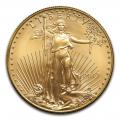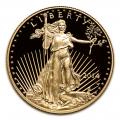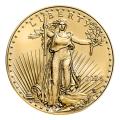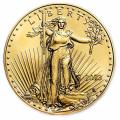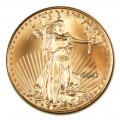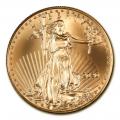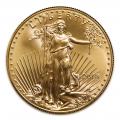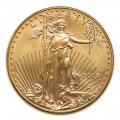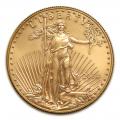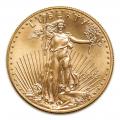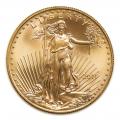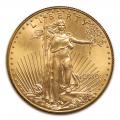One Ounce Uncirculated American Gold Eagles

Since the passage of the Gold Bullion Act of 1985, the American Gold Eagle Bullion coins have been diligently produced each year. Ronald Reagan signed the bill into action, forever changing the US precious metals industry. The first American Eagle was released in 1986 and was offered in sizes of 1 oz, 1/2 oz, 1/4 oz, and 1/10 oz.
American Gold Eagles are produced annually, by the US Mint, and carry the same design year after year. In order to preserve the crispness of the strike, the US Mint throws out the dies every year, and makes brand new ones for the succeeding year. The American Gold Eagles are 22-karat pure, containing an alloy of silver and copper lending to the coin's resistance to wear. Compared to other gold bullion coins, the American Gold Eagle is a larger and stronger coin.
The American Gold Eagle is the United States' official gold bullion coin and remains an homage to one of the most influential gold coins in the nation's history. The obverse follows the artistic design created by Augustus Saint-Gaudens, for the $20 Gold Double Eagles, issued from 1907-1933. Saint-Gaudens was exclusively picked by president, Theodore Roosevelt, to design an image that would be a part of US history, while also reinvigorating US gold coinage.
Background of the American Gold Eagle
The American Gold Eagles are the first gold coins to be minted since 1933, in the United States. When the Gold Bullion Act of 1985 was passed, the legislation demanded that there would be four weight sizes offered and two different types of coins minted. This resulted in the American Gold Eagle containing the 1 oz, 1/2 oz, 1/4 oz, and 1/10 oz in sizes. There were also two conditions minted, brilliant uncirculated and proof (although the proof condition was only offered in 1 oz increments at first). The legislation also specified that the precious metals used, in the making of the American Gold Eagle, would come from US mines.
Many people confuse the American Gold Eagles with the "double eagles" of the Pre-1933 gold coin program. The double eagles are the $10 gold coins that once held the title of highest monetary value gold coin. In 1850, the release of the $20 Liberty excited the public and the need for the $10 double eagles decreased. Augustus Saint-Gaudens was personally approached by Theodore Roosevelt to design the coin that would replace the $20 Liberty so the $20 Saint-Gaudens gold coin was born.
Design of the American Gold Eagle
Augustus Saint-Gaudens was an American Sculptor, who specialized in the ideals of the American Renaissance. His design, of the $20 Saint-Gaudens gold coin, was the inspirational design of the American Gold Eagle. Although some aspects of the original design have been updated, such as the number of stars that hug the edge of the rim, the American Gold Eagle is a modern homage to the classic. Miley Busiek, also an American sculptor, honored Saint-Gaudens' timeless design while recreating something original as well.
The obverse, of the American Gold Eagle, displays a fierce Lady Liberty, walking gallantly away from the US Capital Building in the background. Her robe flows with each stride she takes, and her hands are holding an olive branch, while the other is grasping a lighted torch. The olive branch represents the country's desire for ultimate peace. The torch is the symbol of enlightenment and has been used, in the United States, as a means to freedom and liberty; enlightenment births freedom. Next to her is the coin's date of mintage; from 1986-1991, the coin's date was cast in Roman Numerals. Along the rim are 50 stars, each representing a US state, a design that has been used on other emblematic US coins, such as the Morgan Silver Dollar. The original design featured only 46 stars, since that was how many states existed from 1907-1933.
Hand-picked by the Founding Fathers, the Bald Eagle became the nation's emblem; representing strength, independence, and leadership. Miley Busiek features a Bald Eagle family, on the reverse of the American Gold Eagle; a male, female, and a hungry baby. The representation of these three eagles depicts the country's strength,in the past, present, and future. The king of the birds of prey nests within a bed made of olive branches with the coin's weight, purity, and monetary value written underneath the eagle family.
Production of the American Gold Eagle
The US Mint prides itself on the high quality and precise production value of the American Gold Eagle. To make the perfect coin, the process is extremely meticulous. The process begins with a blank put through a spinning drum. When that blank comes out, on the other end, a specialist handles the coin with white gloves to ensure maximum care. The coin is then placed, by hand, into the coin press, where a high pressure strike is released. The individualized care, per coin, results in a clean, crisply minted product. Investors and collectors are aware of the caution that is used minting the American Gold Eagle, making it the official bullion coin in the United States.
The American Gold Eagle minting process varies slightly depending on the ideal finish of the coin. There are three finishes offered for the 1 oz American Gold Eagle Bullion coins.
- Brilliant Uncirculated: Each American Gold Eagle, in every size increment, is offered in BU condition. Brilliant Uncirculated condition is when a coin maintains its original mint luster since it wasn't placed in circulation, although it was intended for it.
- Proof: The Proof American Gold Eagles were minted, in just 1 oz increments, in 1986. By 1988, the Proof American Gold Eagle Coin became available in four sizes: 1 oz, 1/2 oz, 1/4 oz, and 1/10 oz. Unlike its brilliant uncirculated counterpart, the Proof American Gold Eagle's packaging is more aesthetically pleasing. The coin itself is encased in an appropriately fitted capsule then placed into a velvet presentation box with its Certificate of Authenticity. The presentation box is then protected by an official US Mint cardboard box.
- Burnished: First created in 2006, the 20th anniversary of the American Gold Eagle program, the Burnished Gold Eagles were minted by the West Point Mint. The Burnished versions are the only gold eagles that carry a mint-mark, which is the "W." A burnished eagle was produced for each size variety (1 oz, 1/2 oz, 1/4 oz, and 1/10 oz), but switched to only minting 1 oz coins in 2009, due to a stall in proof and burnished Gold Eagle production.
Important Mintages
The amount of 1 oz American Gold Eagles produced yearly varies. Although the American Gold Eagles were first released in 1986, making it a high demand year, that was also one of the highest minted coins in the program. Since the American Gold Eagle's value is dependent on its gold purity and its numismatic value, collectors and numismatists tend to look for the lower minted dates. Here are a few 1 oz eagles to look out for:
- 1995: 200,636 minted
- 1996: 189,148 minted
- 2001: 143,605 minted
- 2006: 237,510 minted; 20th Anniversary
- 2007: 140,016 minted
- 2018: 191,000 minted


